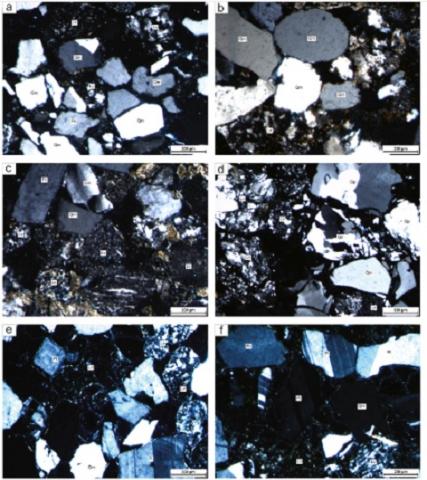Carlos Oscar Limarino, Sergio Roberto Giordano
2 016
Journal of South American Earth Sciences Volume 66, March 2016, Pages 208-231
The aim of this paper is to study the provenance of Late Cretaceous sandstones deposited along the south flank of the Golfo San Jorge Basin. For this purpose, detrital modes of three hundred thirty-seven sandstone samples collected in the Mina del Carmen, Bajo Barreal, and Cañadón Seco Formations were studied in ten oil fields. According to the modal composition of the sandstones, six petrofacies were defined allowing the identification of not only principal, but also secondary provenance areas. The QVM and VQM petrofacies are more than 20% metamorphic, sedimentary, and polycrystalline quartz clasts (Lm + Ls + Qpg > 20%), evidencing a secondary signal of basement supply masked by a predominant volcanic provenance. The petrofacies VP and VF are characterized by Lm + Ls + Qpg <20% and more than 20% total feldspar (Pm + Om >20%.), which indicate a supply of sediment from volcanic terrains and scarce derivation of materials from basement rocks. Based on the plagioclase/k-feldspar ratio, the VF petrofacies is interpreted to be dominated by the supply of sand grains from the Andean volcanic-arc, while VP is supposed have originated through the erosion of intermediate volcanic rock outcroppings in the Macizo del Deseado. Finally, both the VQ and QV petrofacies show Lm + Ls + Qpg <20% and Pm + Om<20%, indicating a provenance of volcanic areas coupled with minor contributions from basement rocks. During the Late Cretaceous, the Golfo San Jorge Basin underwent a sag phase that was characterized by very scarce volcanism and tectonic activity. Although these conditions did not favor defined patterns in the vertical stacking of petrofacies, the sandstones exhibit remarkable changes in their regional distribution, which were determined by the paleogeography of the basin and differences in basement composition within the source areas. Finally, a paleogeographic model for sediment circulation in the basin is proposed. This model recognizes the main fluvial dispersal trends that flowed northwest to southeast and transported large amounts of volcanic clasts (associated with petrofacies VF-VQ). To the extent that rivers flowed eastward, a secondary supply from the Precambrian basement, which were composed of low-to high-grade metamorphic rocks, was also important (petrofacies association VQM and QVM). The southwestern area of the basin is dominated by VP petrofacies that record the supply of plagioclase-rich volcanic clasts. This petrofacies likely corresponds to the erosion of Jurassic volcanic units that crop out in the Macizo del Deseado.

